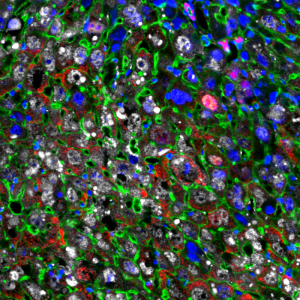Other vertebrates, such as fish and lizards, can regenerate organs more effectively than mammals. Salk researchers have discovered a mechanism to partially restore the young condition of liver cells, allowing them to repair damaged tissue at a quicker rate than previously thought. The findings, which were published in Cell Reports on April 26th, 2022, show that reprogramming molecules can increase cell development in mice, resulting in greater liver tissue regeneration.
 Liver cells were partially reprogrammed into younger cells (red) using Yamanaka factors (white). The cell nuclei (blue) and cytoskeletal proteins (green) are also shown. Image Credit: Salk Institute.
Liver cells were partially reprogrammed into younger cells (red) using Yamanaka factors (white). The cell nuclei (blue) and cytoskeletal proteins (green) are also shown. Image Credit: Salk Institute.
We are excited to make strides at repairing cells of damaged livers because, someday, approaches like this could be extended to replacing the whole organ itself. Our findings could lead to the development of new therapies for infection, cancer and genetic liver diseases as well as metabolic diseases like nonalcoholic steatohepatitis (NASH).”
Juan Carlos Izpisua Belmonte, Study Corresponding Author and Professor, Gene Expression Laboratory, Salk Institute
Professor Izpisua Belmonte is also a holder of the Roger Guillemin Chair.
The researchers previously demonstrated in mice that four cellular reprogramming molecules—Oct-3/4, Sox2, Klf4, and c-Myc, collectively known as “Yamanaka factors”—can halt the aging process and boost muscle tissue regeneration ability.
The scientists utilized Yamanaka factors in their current work to determine if they might boost liver size and function while also increasing the mice’s lifespan. The procedure entails partially reverting mature liver cells to “younger” stages, promoting cell proliferation.
Unlike most of our other organs, the liver is more effective at repairing damaged tissue. To find out if mammalian tissue regeneration could be enhanced, we tested the efficacy of Yamanaka factors in a mouse liver model.”
Mako Yamamoto, Study Co-First Author and Staff Researcher, Izpisua Belmonte lab, Salk Institute
Many researchers in the area are dealing with how to regulate the expression of factors that are essential to improve cell function and rejuvenation, as some of these molecules can induce uncontrolled cell proliferation, as seen in cancer.
To get around this, Izpisua Belmonte’s team utilized a one-day Yamanaka factor procedure, in which the mice were only treated for one day. By obtaining periodic samples and closely watching how cells divided over numerous generations, the team was able to trace the activities of the partly reprogrammed liver cells. There were no tumors in any of the mice after nine months—roughly a third of the animal’s life span.
Yamanaka factors are truly a double-edged sword. On the one hand, they have the potential to enhance liver regeneration in damaged tissue, but the downside is that they can cause tumors. We were excited to find that our short-term induction protocol has the good effects without the bad—improved regeneration and no cancer.”
Tomoaki Hishida, Study Co-First Author and Former Postdoctoral Fellow, Izpisua Belmonte Lab, Salk Institute
Hishida is currently an associate professor at Wakayama Medical University in Japan.
While researching this reprogramming mechanism in a lab dish, the researchers uncovered a second discovery: Top2a is a gene involved in liver cell reprogramming that becomes highly active one day following Yamanaka factor treatment. Topoisomerase 2a, an enzyme that enables break apart and reunite DNA strands, is encoded by Top2a.
The researchers noticed a 40-fold reduction in cellular reprogramming rates when researchers suppressed the gene that reduced Topoisomerase 2a levels, resulting in substantially fewer young cells. The precise involvement of Top2a in this process will be studied in the future.
Izpisua Belmonte adds, “There is still much work to be done before we can fully understand the molecular basis underlying cellular rejuvenation programming approaches. This is a necessary requirement for developing effective and universal medical treatments and reversing the effects of human disease.”
In addition to being a professor at the Salk Institute, Izpisua Belmonte is the Institute Director of Altos Labs Inc.
Source:
Journal reference:
Hishida, T., et al. (2022) In vivo partial cellular reprogramming enhances liver plasticity and regeneration. Cell Reports. doi.org/10.1016/j.celrep.2022.110730.